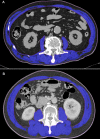The Relationship between Sarcopenia and Systemic Inflammatory Response for Cancer Cachexia in Small Cell Lung Cancer
- PMID: 27537502
- PMCID: PMC4990336
- DOI: 10.1371/journal.pone.0161125
The Relationship between Sarcopenia and Systemic Inflammatory Response for Cancer Cachexia in Small Cell Lung Cancer
Abstract
Background: The prognostic significance of sarcopenia, an important component of cancer cachexia, has been demonstrated in oncologic patients. Catabolic drivers have been suggested to be key features of cancer cachexia.
Objective: To determine the relationship between systemic inflammatory markers and CT-determined muscle mass in patients with SCLC.
Methods: Cross-sectional muscle areas were evaluated at the level of the third lumbar vertebra (L3) using baseline CT images in 186 SCLC patients. Sarcopenia was defined as a L3 muscle index (L3MI, muscle area at L3/height2) of < 55 cm2/m2 for men and of < 39 cm2/m2 for women. Systemic inflammatory markers investigated included serum white blood cell count (WBC), neutrophil: lymphocyte ratio (NLR), C-reactive protein (CRP), and albumin.
Results: Mean L3MI was 47.9 ± 9.7 cm2/m2 for men and 41.6 ± 7.0 cm2/m2 for women. Sarcopenia was present in 128 patients (68.8%), and sarcopenic patients had significant serum lymphocyte counts and albumin levels (p = 0.002 and 0.041, respectively), and higher NLRs and CRP levels (p = 0.011 and 0.026) than non-sarcopenic patients. Multivariable analysis revealed that CRP independently predicted L3MI (β = -0.208; 95% CI, -0.415 to -0.002; p = 0.048), along with gender and BMI (p values < 0.001) and performance status (p = 0.010).
Conclusion: The present study confirms a significant linear relationship exists between CT-determined muscle mass and CRP in SCLC patients. This association might provide a better understanding of the mechanism of cancer cachexia.
Conflict of interest statement
Figures


Similar articles
-
Evaluation of sarcopenia in small-cell lung cancer patients by routine chest CT.Support Care Cancer. 2016 Nov;24(11):4721-6. doi: 10.1007/s00520-016-3321-0. Epub 2016 Jun 30. Support Care Cancer. 2016. PMID: 27364150
-
Prognostic Significance of CT-Determined Sarcopenia in Patients with Small-Cell Lung Cancer.J Thorac Oncol. 2015 Dec;10(12):1795-9. doi: 10.1097/JTO.0000000000000690. J Thorac Oncol. 2015. PMID: 26484630
-
Prognostic significance of cachexia score assessed by CT in male patients with small cell lung cancer.Eur J Cancer Care (Engl). 2018 Jan;27(1). doi: 10.1111/ecc.12695. Epub 2017 Apr 20. Eur J Cancer Care (Engl). 2018. PMID: 28426181
-
Impact of sarcopenia in the management of urological cancer patients.Expert Rev Anticancer Ther. 2017 May;17(5):455-466. doi: 10.1080/14737140.2017.1301209. Epub 2017 Mar 8. Expert Rev Anticancer Ther. 2017. PMID: 28271727 Review.
-
Differentiating Sarcopenia and Cachexia Among Patients With Cancer.Nutr Clin Pract. 2017 Feb;32(1):30-39. doi: 10.1177/0884533616680354. Epub 2016 Dec 15. Nutr Clin Pract. 2017. PMID: 28124947 Review.
Cited by
-
Prognostic role of the advanced lung cancer inflammation index in cancer patients: a meta-analysis.World J Surg Oncol. 2019 Nov 2;17(1):177. doi: 10.1186/s12957-019-1725-2. World J Surg Oncol. 2019. PMID: 31677642 Free PMC article.
-
Sarcopenia defined by skeletal muscle mass index at the third lumbar vertebra is a prognostic factor for extensive-stage small cell lung cancer patients: a retrospective study.J Thorac Dis. 2022 Jul;14(7):2645-2651. doi: 10.21037/jtd-22-782. J Thorac Dis. 2022. PMID: 35928624 Free PMC article.
-
The IMPACT study: early loss of skeletal muscle mass in advanced pancreatic cancer patients.J Cachexia Sarcopenia Muscle. 2019 Apr;10(2):368-377. doi: 10.1002/jcsm.12368. Epub 2019 Feb 4. J Cachexia Sarcopenia Muscle. 2019. PMID: 30719874 Free PMC article.
-
Prognostic Usefulness Of Advanced Lung Cancer Inflammation Index In Locally-Advanced Pancreatic Carcinoma Patients Treated With Radical Chemoradiotherapy.Cancer Manag Res. 2019 Oct 7;11:8807-8815. doi: 10.2147/CMAR.S222297. eCollection 2019. Cancer Manag Res. 2019. PMID: 31632140 Free PMC article.
-
Comparison of the Prognostic Value of Systemic Inflammation Response Markers in Small Cell Lung Cancer Patients.J Cancer. 2019 Apr 3;10(7):1685-1692. doi: 10.7150/jca.29319. eCollection 2019. J Cancer. 2019. PMID: 31205524 Free PMC article.
References
-
- Yang CW, Li CI, Li TC, Liu CS, Lin CH, Lin WY, et al. Association of Sarcopenic Obesity with Higher Serum High-Sensitivity C-Reactive Protein Levels in Chinese Older Males—A Community-Based Study (Taichung Community Health Study-Elderly, TCHS-E). PLoS One. 2015;10: e0132908 10.1371/journal.pone.0132908 - DOI - PMC - PubMed
MeSH terms
Substances
LinkOut - more resources
Full Text Sources
Other Literature Sources
Medical
Research Materials
Miscellaneous

